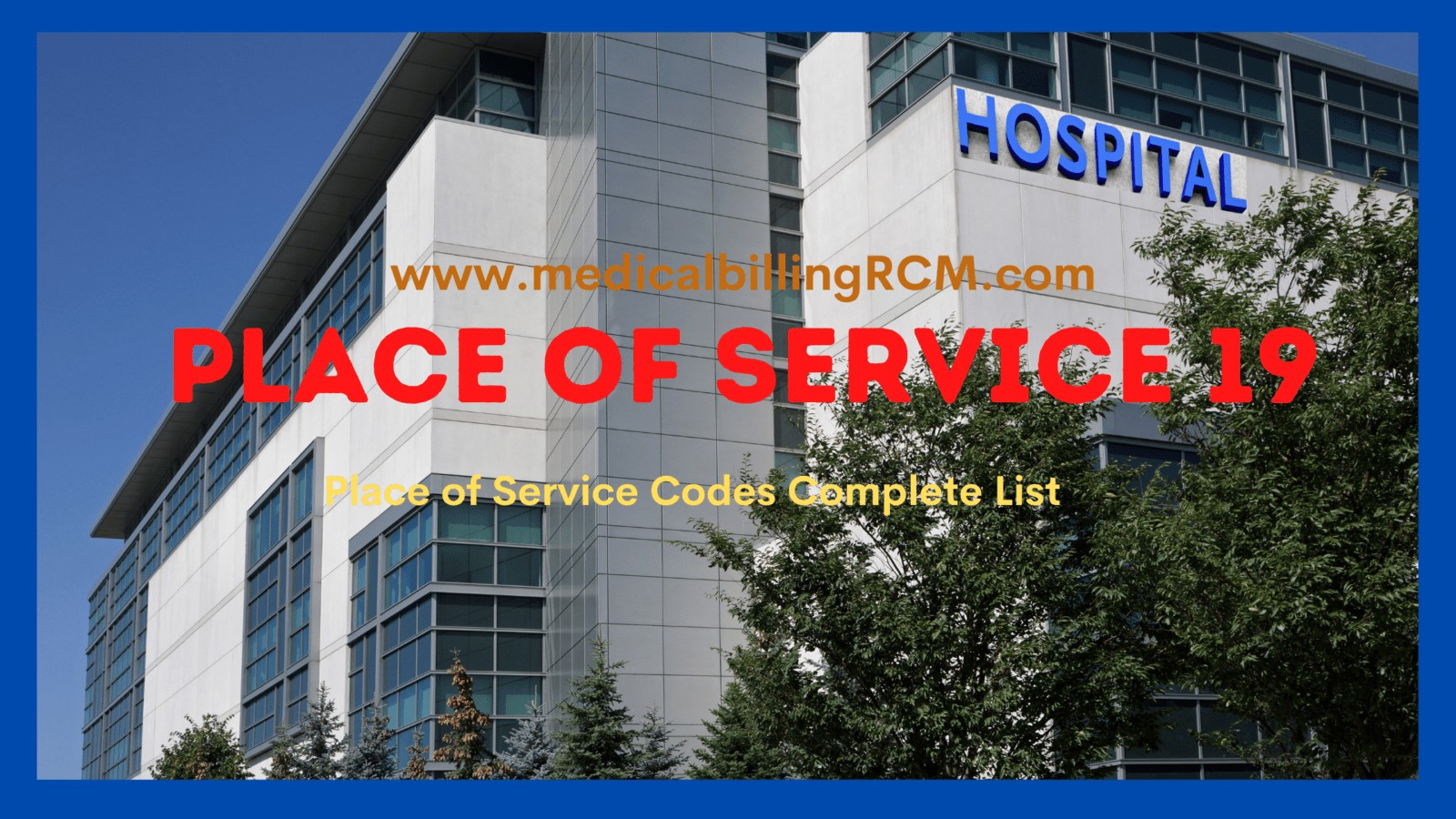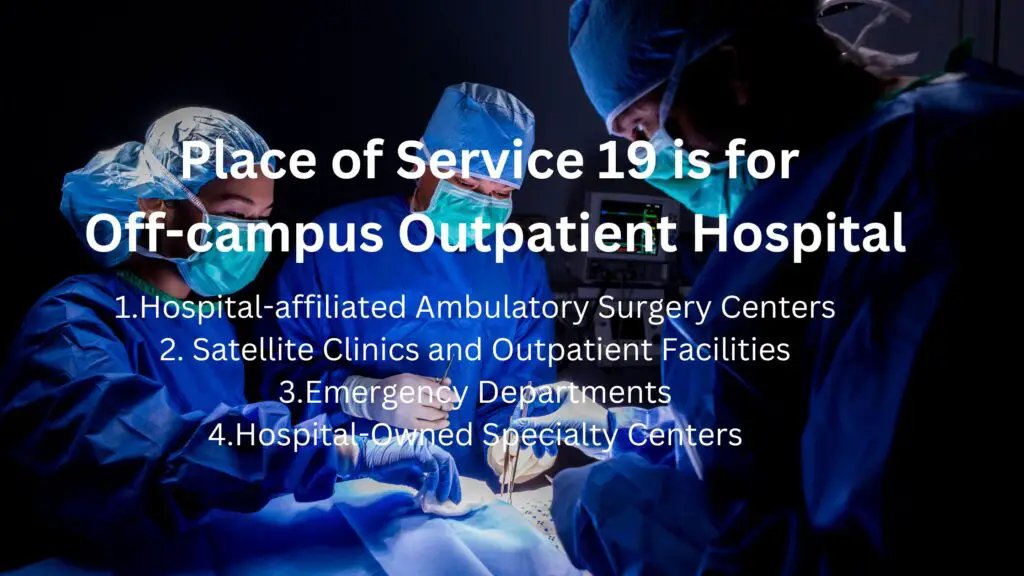Are you familiar with Place of Service 19 in Medical Billing? If you’re involved in the medical billing industry, understanding the nuances of different place of service codes is crucial. In this comprehensive guide, we’ll delve into the specifics of Place of Service 19 and how it impacts medical billing. From its definition to everyday use cases and best practices, we’ve got you covered.
POS or Place of Service codes is used during different claims where every code has significance. They are related to the location where the medical services are provided to the patients. Place of service 19 represents Off Campus-Outpatient Hospital location
What is POS 19 in Medical Billing?
Place of Service 19, used in medical billing as Off Campus-Outpatient Hospital, is a location where medical services are provided to patients outside the main hospital campus. It refers to a healthcare facility that operates under the umbrella of a hospital but is physically separate from the hospital building. These off-campus facilities significantly expand access to healthcare services and reduce the burden on overcrowded hospital departments.
That’s in case, the patient lacks the ability to visit the hospital or needs special care.
How is Place of Service 19 (POS 19) Different from Other Codes?
While Place of Service 19 represents an off-campus outpatient hospital, it’s essential to understand how it differs from other places of service codes. Let’s briefly compare Place of Service 19 to a few other relevant codes:
- Place of Service 21: Inpatient Hospital – Place of Service 21 is used when medical services are rendered to patients admitted to a hospital as inpatients. Unlike Place of Service 19, this code specifically relates to services provided within the hospital premises.
- Place of Service 22: On-Campus-Outpatient Hospital – Place of Service 22 covers outpatient hospital services provided on the main campus. It includes services offered in outpatient departments or clinics within the hospital’s primary building.
- Place of Service 11: Office – Place of Service 11 designates medical services provided in a physician’s office or clinic, which is not affiliated with a hospital.
Understanding these distinctions is essential to code and bill medical services accurately.
Common Use Cases for Place of Service 19
Now that we have a basic understanding of Place of Service 19, let’s explore some everyday use cases where this code is applicable:
1. Hospital-affiliated Ambulatory Surgery Centers
Place of Service 19 is frequently used for ambulatory surgery centers (ASCs) that operate as separate entities but are closely associated with a hospital. These ASCs provide surgical procedures that do not require inpatient admission, making them an ideal choice for patients seeking outpatient care.
2. Satellite Clinics and Outpatient Facilities
Hospitals often establish satellite clinics and outpatient facilities to extend their reach and cater to patients in distant areas. These facilities are physically separate from the main hospital campus but offer various medical services, including consultations, diagnostics, and minor procedures. Place of Service 19 indicates that the services were provided at an off-campus outpatient hospital facility.
3. Emergency Departments
In some cases, off-campus emergency departments may be classified under Place of Service 19. These emergency departments are equipped to handle urgent medical situations but need more comprehensive resources than a full-scale hospital.
4. Hospital-Owned Specialty Centers
Specialty centers owned and operated by hospitals but off-campus fall under Place of Service 19. These centers focus on specific medical specialties, such as cardiology or orthopedics, and provide outpatient services to patients.
Why was POS 19 introduced?
The POS 19 was mainly introduced to keep a track of statistics of off-campus outpatient hospitals that provide services to patients.
What does POS 19 Signify?
These two-digit codes are used to provide a clear understanding of different medical instances of locations easily. Whenever POS 19 is use in a form, it is used for patients who are registered under the main hospital.
However, they receive certain services in the off-campus department; they are called outpatients. They help to keep a clean record of all the out-patients that are being provided with this service.
The Place of Service 19 is one of the many POS codes, and it is essential to know the details of every pos code clearly.
It is because these codes are a must to be mentioned during medical billing if one comes across medical services to be plotted off-campus.
Conclusion:
Understanding Place of Service 19 in Medical Billing is essential for healthcare providers and medical billing professionals. By accurately using this code, providers can ensure proper reimbursement for services provided at off-campus outpatient hospital facilities.
POS 19 FAQs:
Ans. POS 19 is a unique code that includes off-campus locations where doctors of the campus provide services in these off-campus locations.
They are off from the main hospital, however, the patient is register under the main hospital but claims certain services at these off-campus locations.
Ans. No. POS 22 refers to an on-campus outpatient hospital, however, POS 19 is use when the medical services are provide in a location off the main campus of the medical institution.
Even though similar descriptions are use for both, they are partially different from each other.
Ans. The Place of Service codes plays a vital part when it comes to submitting policy claims to insurance companies. So when a provider submits the claims mentioning the wrong place of service, that may lead to denial of claims from the insurance companies.
Ans. To substantiate the use of POS 19, it’s crucial to maintain clear and accurate documentation. This documentation should include the address of the off-campus facility, the services provided, and the service date. It’s also recommended to have a written agreement between the hospital and the off-campus facility outlining their relationship.
Ans. Using POS 19 correctly is crucial for accurate reimbursement. The reimbursement rates for services provided at off-campus facilities may differ from those within the main hospital campus. Healthcare providers should ensure they follow the guidelines and regulations set by payers to receive appropriate reimbursement.
Ans. Yes, a facility can have multiple places of service codes based on the different locations and services it offers. Assigning the appropriate code for each service rendered is essential to ensure accurate billing.
Ans. While Place of Service 19 offers flexibility for off-campus facilities, it’s important to be aware of any restrictions imposed by payers. Some payers may have specific guidelines on using this code, such as restrictions on the distance between the main hospital campus and the off-campus facility.
Ans. Yes, there is a difference in billing between Place of Service 19 and Place of Service 22. Place of Service 19 represents off-campus facilities, while Place of Service 22 refers to outpatient services provided on the main hospital campus. Billing and reimbursement rates may vary for these locations, so using the correct code for accurate billing is important.
Ans. Healthcare providers can ensure compliance with Place of Service 19 requirements by staying updated on the latest guidelines and regulations from payers and regulatory bodies. Maintaining accurate documentation, having proper agreements, and submitting claims with the correct place of service code is essential to ensure compliance and avoid potential audits or reimbursement issues.
Related Articles:
Place of Service Codes List in Medical Billing?
POS 99|Place of Service 99 in Medical Billing
CPT Code 99213 Description and Uses
11 Place of Service | POS 11 in Medical Billing
- Place of Service 11 | POS 11 in Medical Billing (2025)
- POS 72 | Place of Service 72 in Medical Billing (2025)
- Place of Service 32 in Medical Billing (2025)
- Place of Service 50 | POS 50 in Medical Billing(2025)
- Place of Service 21 Description (POS 21) in Medical Billing (2025)
- Place of Service 65 | POS 65 in Medical Billing(2025)
- Place of Service 23- Emergency Room Hospital (2025)
- Place of Service 81- POS 81 in Medical Billing (2025)
- Place of Service 12 – POS 12 in Medical Billing (2025)
- Place of Service Codes List in Medical Billing 2025
- Place of Service 99 – Other Place of Service (2025)
- POS 22 in Medical Billing (2026)
- Place of Service 24 – POS 24 in Medical Billing (2026)
- Place of Service 19 | POS 19 Description in Medical Billing (2026)
- POS 34 | Place of Service 34 in Medical Billing
- Place of Service 20 – POS 20 in Medical Billing 2026
- POS 61| Place Of Service 61 in Medical Billing
The author and contributor of this blog "NSingh" is working in Medical Billing and Coding since 2010. He is MBA in marketing and Having vaste experience in different scopes of Medical Billing and Coding as AR-Follow-up, Payment Posting, Charge posting, Coding, etc.


